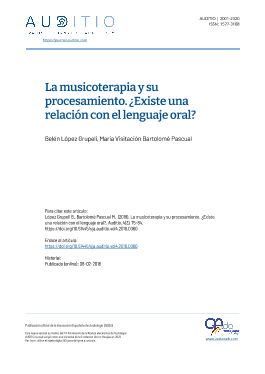La musicoterapia y su procesamiento. ¿Existe una relación con el lenguaje oral?
DOI:
https://doi.org/10.51445/sja.auditio.vol4.2018.0060Palabras clave:
Rehabilitación, musicoterapia, audición, lenguaje, música, percepción, procesamientoResumen
La musicoterapia es una técnica o práctica terapéutica, utilizada actualmente en diferentes campos de ciencias de la salud y la medicina rehabilitadora. La logopedia utiliza la musicoterapia como herramienta para rehabilitar procesos cognitivos complejos, como es el lenguaje. Esta técnica presenta diferentes posibilidades para su utilización, como por ejemplo Rhythmic Auditory Stimulation (RAS), Musical Speech Stimulation (MUSTIM) o Auditory Perception Training (APT).
La revisión bibliográfica realizada en este trabajo, refleja los resultados prometedores publicados por diferentes autores tras utilizar la musicoterapia como práctica terapéutica, permitiendo dar una posible respuesta al título del trabajo, ¿por qué se producen resultados tan beneficiosos en pacientes con alteraciones del lenguaje cuando se tratan con musicoterapia?. En este estudio y con el fin de contestar a esta pregunta se ha investigado en la posible relación anatomofisiológica entre las áreas corticales de la percepción y procesamiento del lenguaje y el de la música.
Descargas
Visibility and Altmetrics
Métricas
Citas
Abdul-Kareem I., Sluming V. 2008. Heschl Gyrus and Its Included Primary Auditory Cortex: Structural MRI Studies in Healthy and Diseased Subjects Journal of Magnetic Resonance Imaging, 28:287-299 https://doi.org/10.1002/jmri.21445
Ardila A., Bernal B., Rosselli M. 2016. Área cerebral del lenguaje: una reconsideración funcional Revista de Neurología, 62 (3): 97-106 3. Boix y Palacián, J. M. 2010. Acústica y audiometría. Alicante, ES: ECU https://doi.org/10.33588/rn.6203.2015286
Burns, D. S. 2001. The effect of the Bonny Method of Guided Imagery and Music on the mood an life quality of cancer patients Journal of Music Therapy, 38(1): 51-65 https://doi.org/10.1093/jmt/38.1.51
Cantero, I., Bartolome M.V. 2016. La comprensión del lenguaje oral en la sordera, la agnosia auditiva verbal y la afasia Auditio: Revista Electrónica de Audiología, 4(3): 67-74 https://doi.org/10.51445/sja.auditio.vol4.2018.0058
Cuetos F., González, J., Vega, M. 2015. Psicología del lenguaje. Madrid, ES: Medica-Panamericana
Escajadillo, J.R. 2014. Oídos, nariz, garganta y cirugía de cabeza y cuello. México: Manual Moderno
GajikLiska, K., Morant Gimeno, A. 2011. Sordera y comunicación: Metodología Verbotonal e implante coclear, Málaga ES: Ediciones Aljibe
García Atarés, N. 2003. Anatomía de los órgano del lenguaje, visión y audición, Madrid ES: Editorial Médica Panamericana
García-Casares, N., Berthier, M.L., Froudist S., González- Santos P. 2011. Modelo de cognición musical y amusia. Elsevier España, 28(3): 179-186 https://doi.org/10.1016/j.nrl.2011.04.010
Groß, W., Linden, U., Ostermann, T. 2010. Effects of music therapy in the treatment of children with delayed speech development - results of a pilot study Complementary and Alternative Medicine, 10: 39-49 https://doi.org/10.1186/1472-6882-10-39
Hallam, S., Cross I., Thaut, M. 2016. The Oxford Handbook of Music Psychology, New York US: Oxford University Press
Hausdorff, J.M., Lowenthal J., Herman T., Gruendlinger L., Peretz, C., Giladi, N. 2007. Rhythmic auditory stimulation modulates gait variability in Parkinson's disease European Journal of Neuroscience, 26: 2369-2375 https://doi.org/10.1111/j.1460-9568.2007.05810.x
Howard, D. M., Angus, J. A.S. 2009. Acoustics and Psychoacoustics 4ª Edición Burlington US: Focal press
Hurkmans, J., Jonkers R., Brujin, M., Bonnstra A.M., Hartman P.P., Arendzen H., Reinders-Messelink, H. A. 2015. The effectiveness of speech-music therapy for aphasia (smta) in five speakers with apraxia o speech an aphasia, Aphasiology, 29(8): 939-964 https://doi.org/10.1080/02687038.2015.1006565
Jara, N., Délano P. H. 2014. Avances en corteza auditiva, Revista de Otorrinolaringología y Cirugía de Cabeza y Cuello, 14, 74: 249-258 https://doi.org/10.4067/S0718-48162014000300010
Kraus, N., Chandrasekaran, B. 2010. Music training for the development of auditory skills Nature Reviews, 2: 599-605 https://doi.org/10.1038/nrn2882
Langers, D., Backes, W., van Dijk, P. 2007. Representation of lateralization and tonotopy in primary versus secondary human auditory cortex NeuroImage, 34: 264-273 https://doi.org/10.1016/j.neuroimage.2006.09.002
Lim, H. A. 2010. Effect of "Developmental speech and language training through music" on speech production in children with autism spectrum disorders, Journal of Music Therapy, 67(1): 2-26 https://doi.org/10.1093/jmt/47.1.2
Lim, H. A., Draper, E. 2011. The effects of music therapy incorporated with applied behavior analysis verbal behavior approach for children with autism spectrum disorders, Journal of Music Therapy, 48(4): 532-550 https://doi.org/10.1093/jmt/48.4.532
Lim, H. A., Miller, K., Fabien, C. 2011. The effects of therapeutic instrumental music performance on endurance level, selfperceived fatigue level, and self-perceived exertion of inpatients in physical rehabilitation, Journal of Music Therapy, 48(2): 124-148 https://doi.org/10.1093/jmt/48.2.124
Limb, C. 2006. Structural and functional neural correlates of music perception, The anatomical record part A, 288A:435-446 https://doi.org/10.1002/ar.a.20316
Marie, D., Jobard, G., Crivello, F., Perchey, G., Petit, L., Mellet, E., Joliot, M., Zago, L., Mazoyer, B., Tzourio-Mazoyer, N. 2015. Descriptive anatomy of Heschl's gyri in 430 healthy volunteers, including 198 left-handers; Brain StructFunct, 220: 729-743 https://doi.org/10.1007/s00429-013-0680-x
Martin, J. 2012. Neuroanatomía. Texto y atlas 4ª Edición MEX: McGraw-Hill
Mateos, L.A. 2011. Terapias artístico creativas 1ª Edición Salamanca ES: Amarú ediciones y autores
McCuley, R. J., Strand, E., Lof, G. L., Schooling, T., Frymark, T. 2009. Evidence-Based Systematic Review: Effects of Nonspeech Oral Motor Exercises on speech American Journal of Speech - Language Pathology, 18(4): 343-360 https://doi.org/10.1044/1058-0360(2009/09-0006)
McGettigan, C., Scott, K. S. 2012. Cortical asymmetries in speech perception: what's wrong, what's right and what's left? Trends in Cognitive Sciences, 5(16): 269-276 https://doi.org/10.1016/j.tics.2012.04.006
Moore, E., Schaefer, R. S., Bastin, M. E., Roberts, N., Overy, K. 2017. Diffusion tensor MRI tractography reveals increased fractional anisotropy(FA) in arcuate fasciculus following music-cued motor training; Brain and Cognition, 116: 40-46 https://doi.org/10.1016/j.bandc.2017.05.001
Norton, A., Zipse, L., Marchina, S., Schalug, G. 2009. Melodic Intonation Therapy Shared insights on how it is done and why it might help; The neurociences and music III: disorders and plasticity, 1169: 431-436 https://doi.org/10.1111/j.1749-6632.2009.04859.x
Peretz, I., Coltheart, M. 2003. Modularity of music processing Nature Neuroscience, 6(7): 688-691 https://doi.org/10.1038/nn1083
Peretz, I., Zatorre R. 2003. The cognitive neuroscience of music, New York US: OXFORD University Press https://doi.org/10.1093/acprof:oso/9780198525202.001.0001
Purves, D., Augustine, G., Fitzpatrick, D., Hall, W., La Mantia A. S., White, L. 2015. Neurociencia, Oviedo ES: Editorial Médica Panamericana
Saenz, M., Langers, D. 2013. Tonotopic mapping of human auditory cortex Hearing Research, 1-11 https://doi.org/10.1016/j.heares.2013.07.016
Schlaug, G., Marchina, S., Norton, A. 2008. From singing to speaking: why singing may lead to recovery of expressive langage function in patients with broca's aphasia Music Perception, 25(4): 315-323 https://doi.org/10.1525/mp.2008.25.4.315
Stemmer, B., Whitaker, H. 2008. Handbook of neuroscience of language 1ª Edición USA: Elsevier
Talavera, P., Gértrudix, F. 2016. El uso de la musicoterapia para la mejora de la comunicación de niños con Trastorno del Espectro Autista en Aulas Abiertas Especializadas, Revista Complutense de Educación, 27(1): 257-284 https://doi.org/10.5209/rev_RCED.2016.v27.n1.45732
Tresguerres, J. A. F. 2005. Fisiología Humana, Madrid ES: McGraw-Hill Interamericana
Zamorano, A. M., Cifre, I., Montoya, P., Riquelme I., Kleber, B. 2017. Insula-Based Networks in Professional Musicians: evidence for Increased Functional Connectivity during Resting State fMRI, Human Brain Mapping, 38: 4834-4849 https://doi.org/10.1002/hbm.23682
Zatorre, R. J., Salimpoor, V. N. 2013. De la percepción al placer: la música y sus sustratos neuronales, LudusVitalis, 21 (40): 293-317

Publicado
Versiones
- 2021-09-15 (2)
- 2018-02-08 (1)
Cómo citar
Número
Sección
Licencia
Derechos de autor 2018 Asociación Española de Audiología

Esta obra está bajo una licencia Creative Commons Reconocimiento 3.0 Unported.
Artículos publicados después de 2020
Los autores retienen el copyright y dan permiso y derecho a la revista para publicar su primera publicación bajo licencia, si no se expresa lo contrario. Creative Commons Attribution License la cual permite a otros el compartir siempre que se de reconocimiento a los autores de la publicación en esta revista. Si los autores deseasen aplicar ciertas restricciones en su permiso para usos no comerciales u obras derivadas, éstos podrán elegir entre las siguientes licencias:
https://creativecommons.org/about/cclicenses/
Publicaciones 2001-2020
Los textos publicados en esta revista en la seccion de "AUDITIO 2001-2020 están sujetos –si no se indica lo contrario– a una licencia de Reconocimiento 3.0 España de Creative Commons. Puede copiarlos, distribuirlos, comunicarlos públicamente, hacer obras derivadas y usos comerciales siempre que reconozca los créditos de las obras (autoría, nombre de la revista, institución editora) de la manera especificada por los autores o por la revista. La licencia completa se puede consultar en http://creativecommons.org/licenses/by/3.0/es/deed.es.








 AUDITIO | Spanish Journal of Audiology
AUDITIO | Spanish Journal of Audiology
